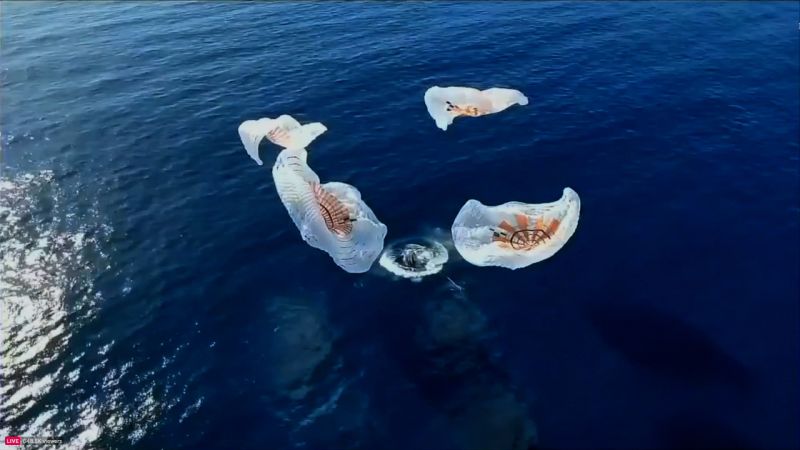SpaceX’s recent mission, Fram2, marks a significant milestone in the realm of commercial human spaceflight, concluding an innovative journey that saw four individuals travel in a unique polar orbit around the Earth. Endeavoring to explore the final frontiers of space, the mission was especially notable as it allowed humans to traverse directly over both the North and South poles – a first in the history of space travel. The mission was financed by the cryptocurrency entrepreneur Chun Wang, a prominent figure in the global tech arena, who has made his mark through Bitcoin mining and other ventures.
The Fram2 crew embarked on their journey with much excitement and anticipation, previously free-flying through orbit since Monday. Their return was notably historic as they executed a splashdown off the coast of California — the first of its kind in SpaceX’s human spaceflight endeavors over the past five years. The crew returned at 9:19 AM PT (12:19 PM ET), with the anticipation and excitement of the public, as SpaceX livestreamed the event, showcasing the recovery of the Crew Dragon capsule.
Throughout their journey, the crew members engaged in various scientific experiments designed to investigate the impacts of space on human health, including the effects of microgravity on their bodies. One of their research tasks involved capturing stunning imagery of auroras from their orbital perspective and documenting personal experiences related to space motion sickness — a common ailment experienced by astronauts that proved particularly troublesome for this crew. In posts shared online, Wang revealed the uncomfortable effects of microgravity, stating that all crew members experienced forms of distress, including nausea and vomiting, particularly during the initial hours in space.
Relief eventually came, as Wang described feeling reinvigorated by the second morning aboard the spacecraft. The crew utilized the viewing cupola of their 13-foot-wide Crew Dragon capsule to document breathtaking images of Earth, providing a unique vantage point. Wang especially noted the extraordinary sight of Antarctica from orbit, emphasizing its pristine white landscape void of any visible human activity.
The crew, which included Norwegian director Jannicke Mikkelsen, robotics researcher Rabea Rogge, and Australian adventurer Eric Philips, all share backgrounds in polar exploration, adding a distinct significance to their mission. Mikkelsen articulated that Fram2 epitomizes an unconventional exploration journey, stating, “We’re not your typical NASA astronauts,” underscoring the unique nature of this privately funded mission that allows participants to engage in research while charting their course through space.
With a robust agenda, the Fram2 mission included attempts at 22 scientific experiments, most of which focused on crew health and well-being. This included an “egress experiment,” aimed at assessing the crew’s ability to exit their spacecraft independently following their splashdown. As part of the study, the crew would navigate various challenges, including retrieving survival gear and utilizing their own skills to leave their capsule—a stark contrast to other missions where assistance comes immediately upon landing.
Importantly, the mission’s trajectory also allowed the crew to observe areas of Earth that other missions haven’t captured from such direct proximity. Prior missions, like the historic 1963 Soviet Vostok 6, came close to a polar orbit, yet none achieved the 90-degree inclination as Fram2 did. This unique orientation permitted the crew to experience sights like Svalbard and view Earth’s polar regions as they had never been viewed before—something that has excited both scientists and enthusiasts alike.
Furthermore, the mission holds ramifications that extend beyond just human experience in space. The research conducted during Fram2 — like hormone level monitoring through urine tests and sleep assessments through wellness-tracking Oura Rings — could provide valuable insights into the physiological impacts of prolonged space travel. Understanding how bodies react to microgravity can aid future missions, especially in the context of long-term objectives such as Mars exploration.
Dr. Eric Donovan from the University of Calgary expressed excitement about the mission’s photographic pursuits, particularly regarding auroras and polar lights. The availability of opportunities for dedicated scientific photography, unrestricted by the constraints of standard missions like those conducted aboard the International Space Station, points to the advantages of private space exploration.
In essence, the Fram2 mission illustrates a confluence of commercial innovation, human experience, and scientific research, paving the way for an era where private entities not only play a crucial role in human space exploration but also contribute to a deeper understanding of our universe. As contributions from these early ventures in space unfold, they may shape the future of exploration, leading to more profound revelations about the final frontiers of space and our very existence on Earth.



